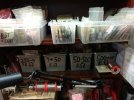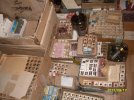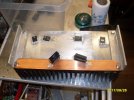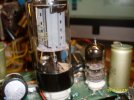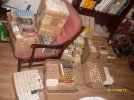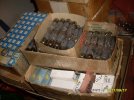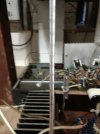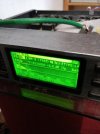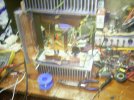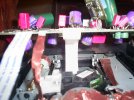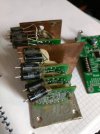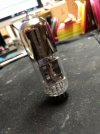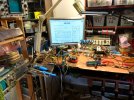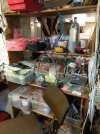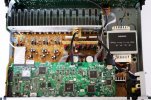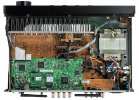Given I don't have tools to measure further - you get what I have!As explanations go, this is rather...subjective?
Most amps don't do well with very low impedances, how they react varies depending on design, typically they will either go into a low power protection mode (reducing power to less than 50% their rated) - or simply self protect in a shutdown....What is it about them in particular that they can't 'handle'?
They may have power supplies that cannot provide sufficient current to provide the voltage/loudness desired... they may have insufficient cooling to keep temperatures under control on the transistors as they have two to four times the current going through them, or the feedback circuits may go unstable into low impedance loads... (or multiple of the above!)
I have a pair of Quad 606/707 amps that are rated as "unconditionally stable into any load" - and the manual provides a chart of continuous and peak power available at different loads. These are rated 135W@8ohm, and 90W@2ohm - (90W @ 2ohm equates to circa 22.5W @ 8ohm in V or Loudness terms !) - so if you are looking at a speaker in terms of SPL/Wm measured at 8ohm - the real wideband capability when combined with this amp (assuming a minimum impedance of 2 ohm) would be calculated based on that minimum...
These however are amps that (within the rated spec) are STABLE at low impedances
I did the following experiments comparing Onkyo SR876 (measured 165W@8ohm stereo, rated 145W@8ohm ), Integra DRX 3.4 (100W@8ohm rated), Quad 606 (135W@8ohm, 90W@2ohm), and Crown XLS2500 (440W@8ohm, 1200W@2ohm).
These were SUBJECTIVE ... take that as you will.
Comparisons were made using stereo music tracks, using either in pure direct straight through or in PLII / DSU 5 channel (no RoomEQ or other EQ of any sort used - levels were matched using my vintage Radio Shack SPL meter)
The speakers are Gallo Reference 3.2 - with minimum impedance of 1.6ohm (Center when used is Gallo Reference AV, also minimum impedance 1.6ohm)
My baseline was the Onkyo SR876 - which I have (had) owned for 15 years...
It handled base stereo and stereo with center very well.
Running the SR876 through the Quad 606 for the front L/R I had an impression that the sound was very very slightly smoother - the difference was slight, and it may well be imaginary - probably not identifiable in double blind.
Running the SR876 through the Crown XLS for the front L/R - much the same as for the Quad 606 - perhaps (maybe!!) a more solid bass during louder sections of music - but again probably not identifiable in DBT, and could be down to confirmation bias.
Replaced the Onkyo SR876 with the current generation DRX 3.4...
Things to keep in mind :
1) the 3.4 is rated at 100W@8ohm
2) the 3.4 weighs around 10kg compared to the SR876 at 23kg - some of that is the larger/heavier chassis, but most of that is the massive hunk of EI transformer Iron, and the big capacitors - brochures of the time touted its "high current capabilities"
Simply replacing the standalone SR876 with the 3.4 - sound quality took an immediate turn for the worse - Dialogue / voices were harder to discern, understand, stereo image was "confused" and soundstage was reduced.
Tried in both straight Stereo and Stereo with Center.
Replaced internal 3.4 amps with either of Crown XLS or Quad 606 power amps - sound immediately cleaned up - system as a whole sounded identical to the setup with the SR876 on its own.
Also tried 3.4 with XLS running L&R, but 3.4 running the C - this was interesting, as once the L&R load was removed from the 3.4, the center channel cleaned up ... the 3.4 could drive a single channel 1.6ohm speaker without any issues, but not 2 or 3 channels of the same speaker type.
So my conclusion ...
1) Heat is not an issue - I am not running it loud enough for the power amp circuits to start to get hot (on either the external amps or the 3.4 / 876)
2) V out is not an issue - all the tested configurations can provide sufficient V out (W out)
Distortion...
I am assuming that the reason the 3.4 sounded bad driving 2 channels is that some form of distortion was rising substantially - what form I don't know as I don't have requisite tools to measure with!
However... 2 identical power amp channels driven together, experienced the audible degradation, where a single channel on its own did not suffer from the degradation.
This indicates that the actual power amp circuits, devoid of the power supply limitation, can handle low impedance loads without issue... but if you put too many of them onto the power supply, then you experience the audible problems.
In using both the Quad 606 and the Crown, I demonstrated to my own satisfaction, that in my particular use case, I did not need large amounts of power - the Quad sounded as good as the Crown, even though at 2 ohm it is rated at less than 1/10th the power.
Well that is really the point isn't it - all these AVR's are officially rated to handle speakers that are nominally rated at 4 ohm - but in reality the vast majority of mass market AVR's cannot properly handle real life 4 ohm speakers - In reality they are designed for no lower than 6 ohm nominal.I'm still rather unclear how current (amperage) itself , divorced from power, is effecting this remarkable positive difference. And yes, let's assume the amp is not being asked to do what it wasn't properly designed to do.
To identify what an amp is capable of with a real life 4 ohm (nominal) speaker, you would need it to be rated into 2 ohm - so you can tell what it can (or cannot) do into the impedance troughs that happen with real life speakers.
I have not seen a 2 ohm rating on ANY AVR... and even bench tests at 4 ohm have frequently shown mass market AVR's going into their various protection modes.
Having said all that - many average AVR buyers, probably would not have noticed anything wrong - the 3.4 was working, it was driving the speakers, it was providing surround sound, Dirac, decoding Dolby and DTS, etc....
And it sounded pretty reasonable doing it.
But comparing it directly to the older (and much more upmarket!) SR876 - the difference in the midrange, voices/dialogue and imaging was immediately noticeable.... and that difference disappeared when I replaced the internal amps with external ones.... even keeping the C channel on the 3.4.
Based on my experience, I would much rather have an amp with the ability to provide plenty of current to drive a lower power rating at much lower impedance, like the Quad, than one like the 3.4, which has a high "headline" figure (100W !!) - but is unable to drive stereo at 5W cleanly into 1.6ohm.
And yes I am guessing that current is the cause of the symptoms experienced... the outcome of my reasoning as per above.
If you can identify a different reason why the symptoms I heard happened, I would love to hear your hypothesis.

